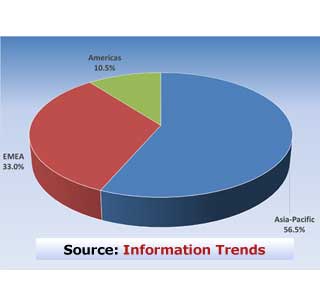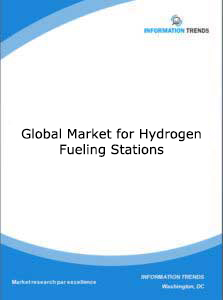
Executive Summary
By year-end 2021, over 800 public hydrogen stations were deployed globally, representing a dramatic increase over 2020. These deployments represent the highest number of station deployments in a single year. Figure 1 shows the breakdown of these stations by region.
The deployments of hydrogen stations have picked up in several countries, particularly in APAC and Europe. In 2021, the highest number of new hydrogen stations were deployed in China, followed by Korea. In Europe, France led the new deployments. Figure 1 provides the share of each region with respect to hydrogen station deployments.
With 2021 as the base year, this report provides 15-year forecasts through the year 2036. During the forecast period, the deployments of hydrogen stations will grow as a function of their declining costs and the uptake of hydrogen FCVs.
The capabilities of hydrogen stations are being enhanced, while their costs are declining. The capabilities include higher fueling pressures, increased fueling capacity, and expanded hydrogen storage.
There is a push to supply these stations with “green” hydrogen, i.e., hydrogen produced from clean energy sources such as solar panels and wind turbines. This trend is in line with the global drive for green energy completely free of carbon.
Information Trends projects that by 2030, the industry in many countries will become sufficiently self-reliant and independent so as not to need any intervention from governmental organizations for its financial sustenance.
South Korea, Austria, and Denmark are the first countries where enough hydrogen stations were deployed to allow an FCV to travel across the country. In the U.S., hydrogen station deployments in California allow an FCV to travel anywhere in the state and be supported by the hydrogen fueling network.
In addition to hydrogen stations for passenger vehicles, hydrogen stations for heavy-duty transportation are increasingly being deployed. These include stations for buses, trucks, and forklifts. In the upcoming years, the fueling stations will begin to supply hydrogen to trains, aircraft, and maritime vessels, further driving their growth.
The sums of money being poured into hydrogen station deployments are staggering. These deployments will generate $9 billion in revenue through 2036. The biggest chunk of the revenue will come from the APAC region, followed by Europe.
Scope of the Study
This is a comprehensive research study on the rapidly evolving market for hydrogen fueling stations globally. The focus of the study is hydrogen stations being built to support vehicular transportation encompassing cars, SUVs, minivans, buses, and trucks, in addition to forklifts, trains, and sea-going vehicles.The study analyzes major industry trends and discusses vendor strategies in building the infrastructure needed to drive the hydrogen FCV market. The study provides forecasts for hydrogen station deployments and vendor revenues. It contains detailed data for each region, and for some of the major countries in each region.
In this study, hydrogen stations are classified as retail, non-retail, and private.
● Retail stations: These are designed for light-duty passenger non-commercial vehicles.
● Non-retail stations: These are designed for commercial vehicles, such as buses, trucks, forklifts, locomotives, and maritime vessels. They include stations being used by companies and organizations for their internal needs.
● Private stations: These stations are being used for trials and R&D.
Both retail and non-retail stations are considered public. In quantifying the market, this study considers only retail and non-retail stations.
This study does not consider Hydrogen-enriched Compressed Natural Gas (HCNG) stations as part of the hydrogen station market. Hydrogen stations offering compression levels below 35-MPa are also beyond the scope of this study.
Executive Summary
Press Release
Table of Contents

Order Report |





